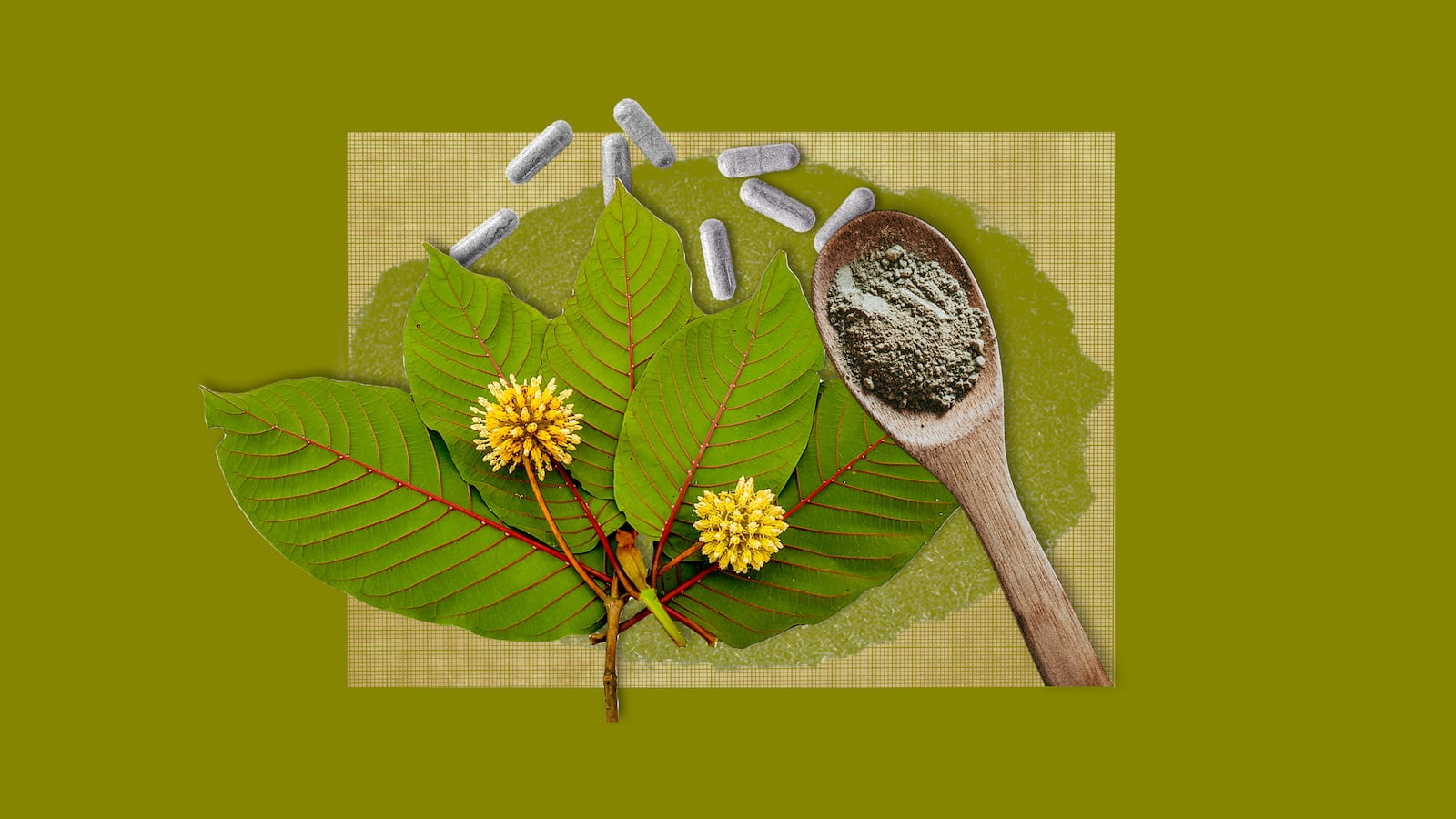Whenever Jonathan feels a craving for methamphetamine, he turns to kratom. Each time, the 41-year-old from Colorado will take 3 milligrams of kratom extract and “toss and wash"—mix the extract into a liquid, and “chug for dear life.”
Jonathan (who requested omission of his last name due to privacy concerns) is 20 years in recovery from a methamphetamine addiction. It hasn’t always been easy. Five years ago, he went through a terrible period of stress which caused an intense desire to use again. It was through personal research that he came across kratom as a potential cure to his withdrawal symptoms. “After my first dose, something switched,” he said. Since then, it has played a key role in helping him manage his methamphetamine cravings and relapsing.
Jonathan is one of many Americans who use kratom, a drug originating from Southeast Asia and spreading rapidly throughout the West in recent years. According to the U.S Department of Health and Human Services’ 2021 National Survey on Drug Use and Health, about 1.7 million Americans over the age of 12 reported using kratom, though experts believe this could be an underestimate.

Derived from the plant Mitragyna speciosa, kratom is known for its reported stimulant and opioid-like effects.
Wikimedia CommonsAt many headshops and vape shops across the country, you’ll find kratom sold alongside vapes, cigarettes, delta-8 and all the other semi-legal cannabinoids—either as raw leaves, capsules, tablets, powder, or concentrated extracts. Derived from the plant Mitragyna speciosa, kratom is known for its reported stimulant and opioid-like effects. Some use it as a stimulant to boost energy and stave off fatigue. For others, it provides a sedative, opioid-like ability to mediate pain relief and promote relaxation. Kratom users, including Jonathan, report the differing effects are dose dependent, but this has not yet been confirmed by science. However, scientists have determined that both of these effects are likely linked to the presence of mitragynine—a chemical compound that interacts with the body’s opioid receptors in a way that’s similar but weaker than classic opioids, but still elicits similar feelings of relaxation. Studies also show the stimulating effects are likely due to activation of adrenergic receptors, serotonergic and dopamine receptors in the body.
As a result, people have found many reasons to take kratom—from the recreational effects, to treating mental health disorders, managing pain, to using it to help recover from addictions to other drugs.
But if you try to educate yourself about kratom, you’ll be deluged with fiercely conflicting information. Legally, it’s not a controlled substance, which means its use is not tightly regulated by the government. But guidance from major health authorities and institutions warn consumers to avoid kratom products due potential addictive qualities, adverse effects and lack of sufficient research. The Food and Drug Administration’s April 2022 statement reads that the agency is concerned that kratom appears to have properties that expose users to the risks of addiction, abuse, and dependence.” The Mayo Clinic’s website says potential side effects of kratom use include weight loss, liver damage, seizure, coma, and even death.
Other health authorities like the National Institute on Drug Abuse (NIDA) and Johns Hopkins Medicine take a less prohibitory approach, noting potential benefits like managing pain withdrawal symptoms and cravings, pain, fatigue, and mental health problems; while acknowledging the existent but rare adverse effects like psychiatric, cardiovascular, gastrointestinal and respiratory problems. They mention the possibility of death, but note that compared to death from other drugs, a very small number have been linked to kratom—in most cases, other contaminants were involved.
Adjacent to the health authorities’ own recommendations are the real-world stories of kratom already visible in the media. Kratom-associated deaths continue to grab headlines in the news—juxtaposed against others in social media who testify to positive experiences with kratom, in which the plant helped them overcome drug dependence or eased withdrawal symptoms. Persuaded in one direction or another, some states have already banned kratom use or are moving forward with such plans; while others have introduced measures to protect—and appropriately regulate—kratom-derived products.
But the drug is about to be debated on the biggest stage possible: the floor of the U.S. Congress. In December, a bipartisan group of lawmakers introduced the Federal Clarity for Kratom Consumers Act to both the House of Representatives and the Senate. If passed, the bill—which will be reintroduced to both chambers later this month–would prevent the Department of Health from implementing any new legal restrictions on kratom than what is already allowed by federal law.
The bill could not arrive at a more pivotal time. Kratom’s emergence as a more mainstream recreational drug shows no signs of slowing down—despite the efforts of the FDA and other health authorities.
Jonathan says he lives a completely different (and better) life than he did 20 years ago when he was addicted to methamphetamine—a change he directly attributes to kratom.
“It’s tempered the cravings for meth that just never go away, such that I don’t feel them anymore,” he told The Daily Beast. “Being free from that for the first time five years ago was stunning.”
Jonathan’s story is far from a one-off. Various survey studies report that many users take kratom to help them manage their own addictions to opioids and other addictive substances, with similarly positive results. Animal studies suggest that mitragynine could be responsible for alleviating withdrawal symptoms.
On the flip side, because mitragynine is binding to the same receptor as other opioids, many critics point out that it could potentially elicit similar addictive qualities as opioids. A few users have reported kratom-related withdrawal symptoms, though these seem to be rare.
According to Aidan Hampson, a pharmacologist and senior advisor in therapeutics at NIDA, the risk of addiction to kratom is not yet clear. However, he told The Daily Beast that it’s not uncommon that the alternative agents used to treat substance use disorders are somewhat addictive (e.g. nicotine substitutes). Even if kratom has addictive qualities, studies have shown that risk of overdose death is much greater with actual opioids. Hampson and others at NIDA are currently working on investigating whether kratom or a pure formulation of kratom could be useful in opioid withdrawal.
“We’re still in a position where we can’t answer that very well because we don’t have a purified clinical drug product yet,” Hampson told The Daily Beast. “But personal testimonies seem to follow similar trends.”
The potential therapeutic benefits of kratom go beyond addiction management. A 2020 study from Johns Hopkins University surveying almost 3000 kratom users found that while 41 percent of respondents used kratom to stop or reduce illicit opioid use, 91 percent also used it to help manage pain; 67 percent found relief from anxiety; and 65 percent from relief from depression symptoms. Other surveys have reported similar trends of additional use for self-treating pain and emotional or mental conditions.
Unfortunately, federal agencies don’t have much of an appetite for funding bigger investigations into these potential applications for kratom. The agency cites concerning reports about the safety of kratom, “The FDA is concerned that kratom appears to have properties that expose users to the risks of addiction, abuse, and dependence,” the FDA told The Daily Beast in a statement. “Scientific evidence, such as data from well-designed clinical studies, are essential in demonstrating medical benefit, especially when a product is being marketed to treat serious conditions and disorders such as opioid use disorder (OUD) and pain. We are not aware of any evidence that would meet the agency's standard for approval of kratom as a drug.”
It’s a bit of a catch-22: the lack of data encourages skepticism against researching kratom; while the skepticism further discourages pursuing new research into kratom.
It doesn’t help that even if there was more interest in researching kratom, federal regulations make administering clinical trials difficult. A March 2022 report in Frontiers in Pharmacology shows there has only been one published clinical trial of kratom’s effects in humans.
“Other people in the real world are out there using it already,” Albert Garcia-Romeu, a behavioral pharmacology researcher at Johns Hopkins University involved with both the 2020 study and the 2022 report, told The Daily Beast. “We have this huge natural experiment going on of people taking drugs, and we don’t know the public health impact of that until something terrible happens.” A regulated clinical trial would open up the path to clearly measure the physiological and psychological effects of kratom on people. “But instead, regulatory barriers are in place that make it near impossible to do this work because of a lot of legal liability and risk aversion.”
Reports of kratom-associated deaths in the news are an especially big dissuading factor. Hampson explained that physicians may file a report about a death where kratom was involved . But these cases can only really be considered anecdotal––in order to make conclusions about the effects of the drug, you really need controlled studies, which these are not.
Dividing the debate for kratom into only two camps—pro and anti—is a bit of an oversimplification. As Garcia-Romeu sees it, there are a few different factions of opponents.
“There are groups who think outright it should be banned and become an illegal substance and that it’s dangerous, which includes people who have family members or friends who have become addicted to kratom or have bad effects of kratom,” he said. “There’s also just people who think drugs are bad and shouldn’t be legal and if their kids get their hands on these drugs, bad things will happen. They’re going to get addicted or overdose. I think that’s a lot of the mentality which is very naive and doesn’t take into account the complexities of the situation.”
And the advocates for kratom fall into just as many subgroups. Some believe that the kratom market should run free without any restrictions or regulations. There are others who are the complete opposite. The advocates, researchers, and kratom users who spoke to The Daily Beast had more nuanced takes.
The American Kratom Association (AKA), a consumer advocacy organization, says it recognizes the potential benefits of the plant, but emphasizes the importance of making sure safe kratom is available to all. Frustrated with the FDA’s obstinate stance on it––and convinced that the agency has a vendetta against the drug––the organization has worked with various states on passing bills that create frameworks for regulation, preparation, distribution, and sale of products. It has also lobbied federal legislators to support the Federal Clarity for Kratom Consumers Act––an initiative they feel is necessary to curb the FDA’s authority on the matter. But regulation and ensuring consumers don’t get adulterated kratom products, remains a key part of their advocacy.
“We think it’s a responsible approach in order to protect consumers rather than letting it be the wild west,” Mac Haddow, senior fellow on public policy at AKA said in an interview. While the vast majority of kratom vendors are opposed to the AKA’s intervention or proposed regulatory measures—preferring to see the infant kratom industry grow and operate freely—the organization says it has found a few who are willing to submit their products to third parties to be tested.
Jonathan is also a strong proponent of use with regulation.
“I do think it should be regulated as there have been instances where it was laced with fentanyl or heavy metals, we need to make sure it doesn’t happen,” he said. “Alcohol is regulated. Marijuana is regulated. Why would we take a different approach with this?”
And while Jonathan acknowledges the horror stories of kratom-associated ailments, he reiterated NIDA’s observation that most individuals who have died had been taking kratom concurrently with other substances.
“I haven’t found good arguments against it,” he said. “But I’ve found a lot of fear leftover from the war on drugs, and a lot of ignorance and misunderstanding.”







